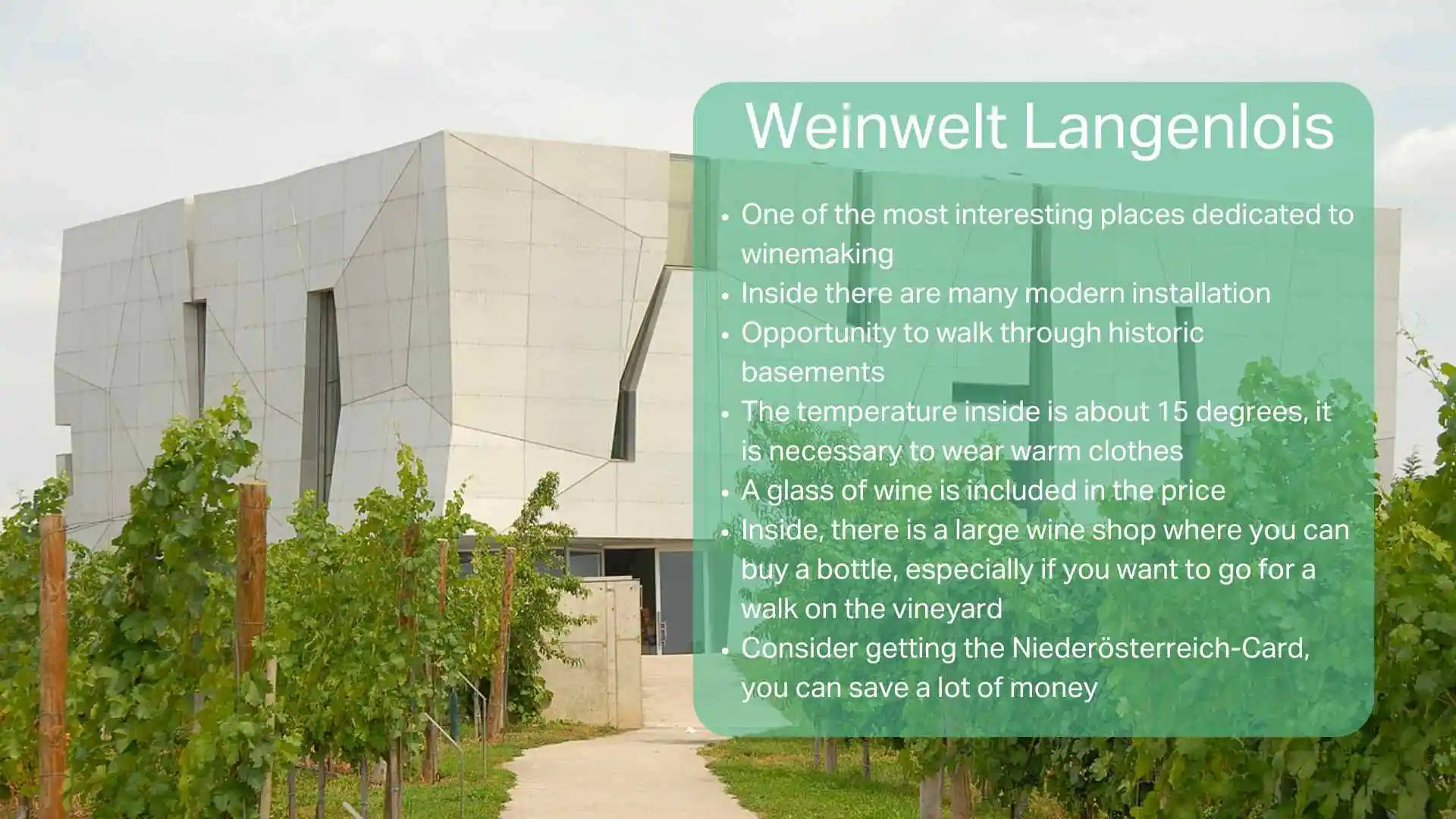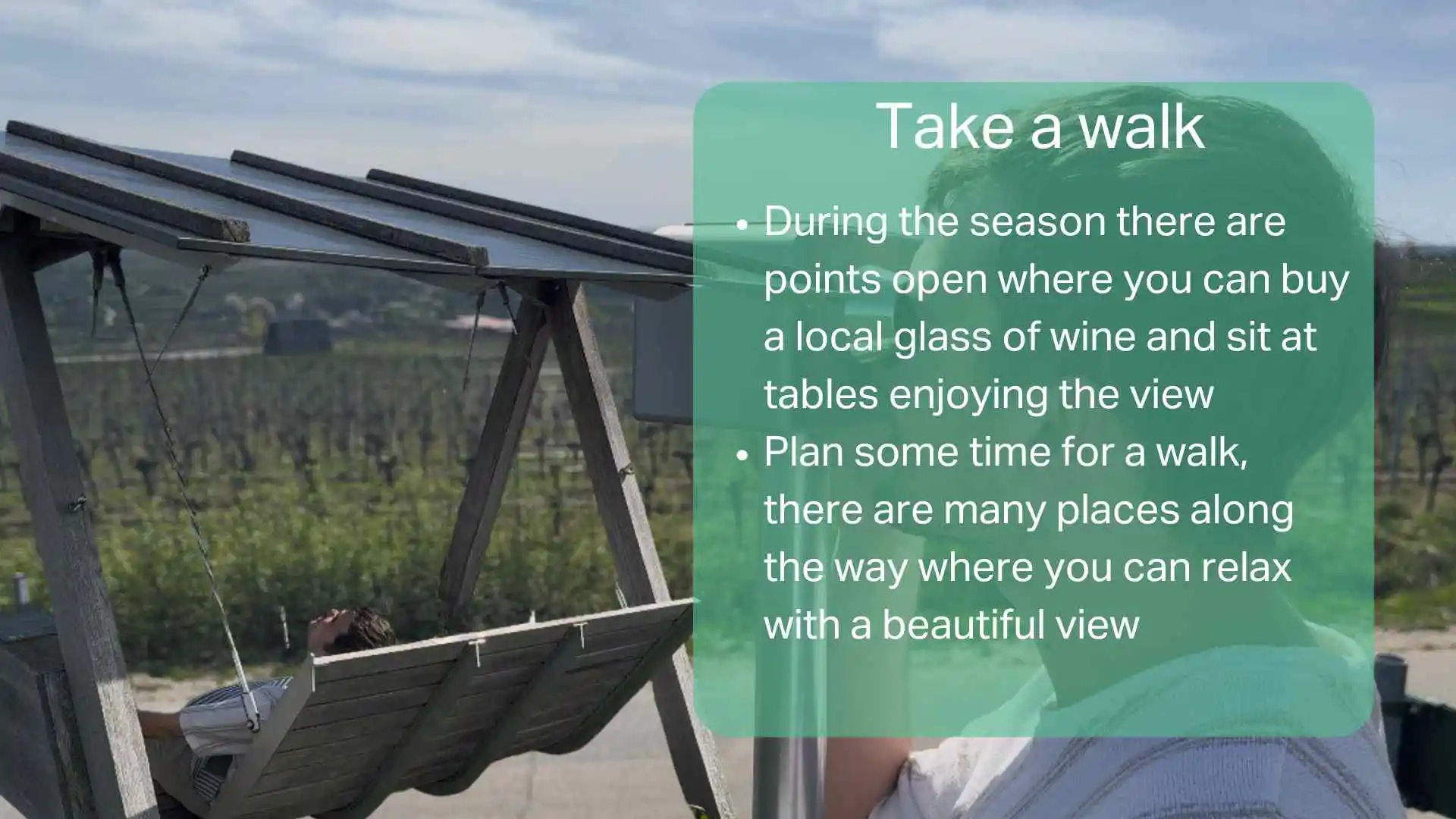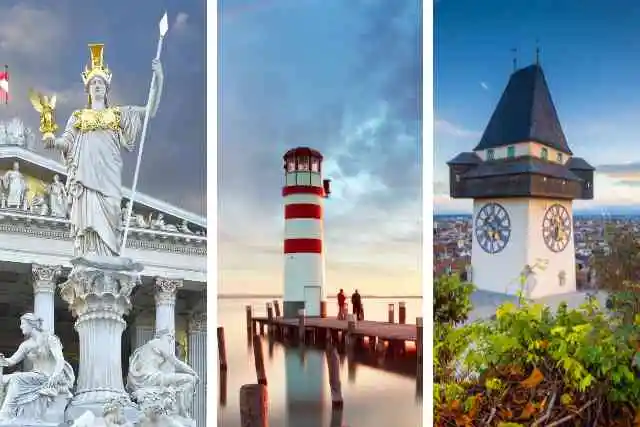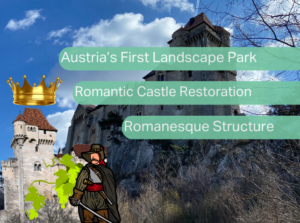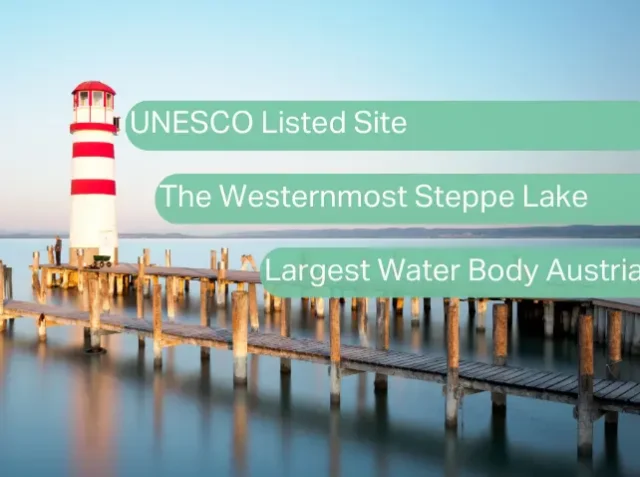Austria's largest wine town, medieval sgraffito art and one of the most beautiful Holy Trinity Columns are all within an hour's drive from Vienna!
Introduction to Langenlois
From Vienna by Public Transport to Langenlois, a charming town in Lower Austria, has a long wine tradition, charming shops, and a beautiful stream that runs through it. It is one of the most fascinating wine destinations in the country, with a museum dedicated to the art of winemaking complemented by charming walking paths that lead through fields of vineyards overlooking magnificent mountains. All of this is just an hour’s drive from the Vienna.

Name
Langenlois derives its name from the old Slavic word “Liubis“, which means “beautiful place“. Some researchers suggest a connection between this name and the Loisbach stream. The name evolved many times throughout history until it became the form we use today.

Overview of Langenlois
Langenlois is the gateway to the Kamptal Cultural Park, famous for its grape plantations. Langenlois is Austria’s largest wine town. More than 800 entrepreneurs cultivate 3,583 hectares of vines. The most popular varieties are Grüner Veltliner and Riesling, with white varieties accounting for 82% of the crop and red varieties 18%. The city currently has a population of ~ 7,582 people.
The Kamptal

The Kamp River, which runs through the region, is about 150 km long and flows into the Danube at Krems. Wines from the Kamp Valley have a unique flavor due to the diversity of soils in the area, including loess, gravel and sandstone.

Historical Background

The history of settlement in the region dates back to the Stone Age, goes through the Roman period, a fact evidenced by numerous finds, but the first mention of Langenlois dates back to the 12th century, during the reign of the Babenbergs. The present town was formed after the union of the two settlements – Lower and Upper Aigen. One of them, agricultural – the second one, a merchant and craft settlement. The town was only granted municipal rights in 1925, although it had already been granted market rights in 1310.
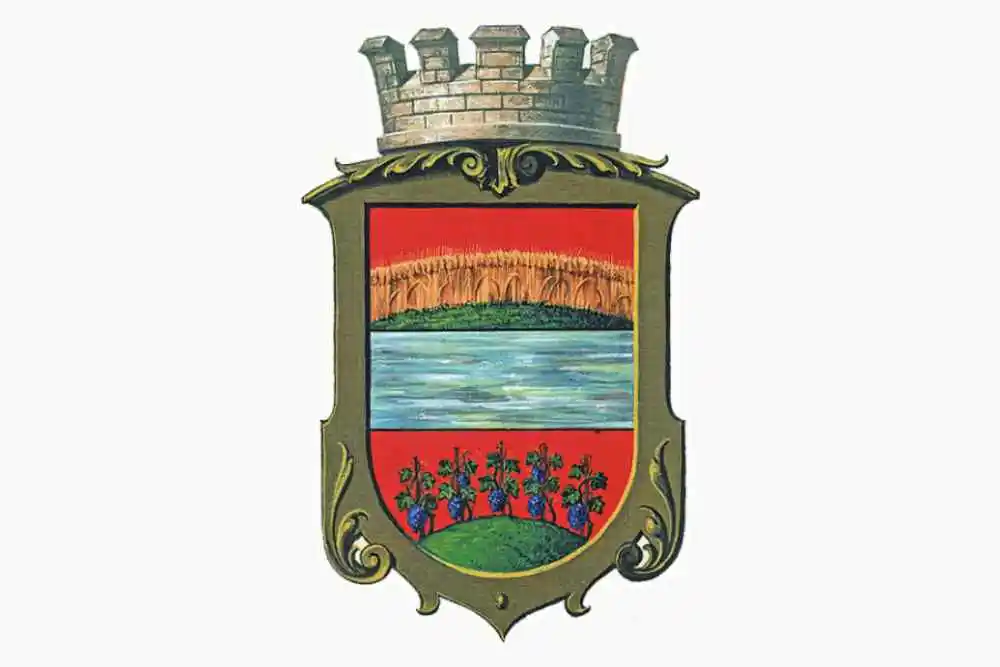
The town’s coat of arms, granted by Emperor Maximilian I in 1518, depicts cornfields, a stream and vineyards.
Langenlois was partially destroyed by the Turks in 1532. There was a Jewish community here in the 17th century, and the Jewish Temple stood in Judengasse, as the name reminds us today. However, the history of the Jewish settlement is not long and lasted only about 50 years. In 1713, the city escaped the plague, which was commemorated by the erection of the Holy Trinity Column in the market square.
Nazi period
In 1938 a plebiscite was held on the annexation of Austria to the German Reich, in which an overwhelming majority of voters voted in favor of annexation – 2972 people voted in favor of joining, one was against. It is worth remembering, however, that the plebiscite was conducted under great fear and manipulation of the Austrian population. The plebiscite can certainly not be regarded as having been held without pressure from people associated with the Nazi party. During the Nazi period, the name of one of the square (Holzplatz) was changed to Adolf Hitler Square.

Stalag XVII B at Gneixendorf, near Krems and Langenlois, was the largest prisoner of war camp in Austria during the Second World War. It held prisoners from many countries, including France, Belgium, Serbia, Poland, Great Britain, Russia and the USA. In October 1943, American air force pilots were brought to the camp. Their planes had been shot down over Reich territory.
About 2000 prisoners died in the camp, mainly from disease and malnutrition. The prisoners were released after the end of the war in 1945. The Krems-Langenlois airport now stands on the site of the former camp, and the only building left is an elevated water tank.
Key Attractions

The Sgraffito House

Formerly known as the ” Guesthouse zur Goldenen Kugel “, is a historic building dating from the 16th century. Its remarkable paintings were discovered in 1962 and depict various dramatic scenes from the Old Testament and Roman history.
The scene with Bathsheba – this scene illustrates the biblical story of Bathsheba. King David seduced her and she became pregnant. To cover up his actions, David set up the death of Bathsheba’s husband. After her husband’s death, David married Bathsheba, but their child died shortly after birth.
Lucretia – a Roman figure, Lucretia was raped and, unable to bear the shame, she committed suicide. Her tragic death spurred Brutus’ revolt, which resulted in the overthrow of the Roman monarchy and the establishment of the Roman Republic.
Judith – in the Old Testament story of Judith, the city of Bethulia was under siege. Judith went into the Assyrian camp on the pretext of negotiations. She charmed the Assyrian leader, who invited her into his tent. When he fell asleep, Judith beheaded him and displayed his head on the city walls, causing the Assyrian army to retreat.
Jael – another Old Testament character, Jael, was involved in the defeat of Israel’s enemies. After a failed invasion, the enemy leader took refuge in Jael’s tent. When he fell asleep, Jael killed him by sticking a tent peg through his head.
The sgraffiti, which are a prominent feature on wealthy houses in this region of Austria, reflect a commitment to humanism. They serve not only as artistic expressions but also as representations of moral and historical lessons.
St. Elisabeth’s Church

Located on Kornplatz next to the Sgraffito House, was historically part of a complex that once included the hospital. This institution served the sick, the poor and those in need of care. Founded in the 13th century, the hospital was located where the bank now stands and remained in service until the 20th century.
The church itself dates back to 1420 and part of the original structure is still visible today. The entrance to St Elisabeth’s is characterised by a statue of St Elisabeth of Thuringia. This architectural and historical feature underlines the long tradition of care and charity associated with the site.
Kornplatz

Formerly a marketplace for the sale of grain products, Kornplatz owes its present shape to the demolition of a house on its northern edge in 1959. At the same time, the Holy Trinity Column was moved to its present position, having previously stood to the west of the square.
Most of the buildings surrounding the square date back to the 16th century, although their facades reflect the results of numerous reconstructions over the years. This historic square, with its evolving architecture and relocated statue, remains an important part of the city’s heritage.
The Holy Trinity Column

Constructed in 1713 as a thanksgiving for protection from the plague, features numerous symbolic elements associated with the number three. The column includes a three-part pedestal, a three-sided base, and three levels of the base. Additionally, there are three statues on its sides.
The three levels of the column symbolize different spheres: the earthly sphere, the saints representing the joint sphere, and the sacred sphere, which includes the pyramid and the clouds. This column is considered one of the most important monuments in Lower Austria, reflecting its historical and religious significance.
The Museum of Local
History

The museum boasts a significant collection of prehistoric objects. In front of the museum stands a statue of Knight Roland – a pillory that is over 450 years old, which was used until 1776 to punish minor criminals.
Inside the museum, visitors can see the largest mammoth fang in Central Europe. The museum also features a notable array of religious objects from the 17th, 18th, and 19th centuries. Additionally, the exhibits include displays about historical guilds and ancient wine-making practices, providing a comprehensive view of the region’s cultural and historical heritage.
Town Hall

The building on this site dates back to around 1390, and it has served as the town’s administrative center since 1522. The current façade, however, is the result of a reconstruction carried out in 1792.
One notable feature is a sculpture of Justice in a niche, which symbolizes the presence of the local court. Additionally, there is a two-headed eagle prominently displayed, with the letter C and the number VI inscribed beneath it, representing Charles VI, who was the father of Maria Theresa. Below this emblem is an inscription that can be translated as: “fair rule, develop through constancy and courage,” conveying principles of justice and governance.
Langenlois Parish Church

The parish church in Langenlois is a significant architectural and historical landmark. Built in the Romanesque style around 1250/60, the church’s most remarkable feature is its altar, crafted around 1500. Originally located in places such as Pöggstall or Vienna, the altar found its current home in Langenlois in 1954.
The altar depicts three saints prominently: Barbara, positioned in the center with a goblet and a host; Catherine, holding a book and a bible; and St. Dorothy, carrying a basket of flowers. Other figures on the altar remain unidentified. Painted below them are St. Agatha, St. Lucia of Syracuse, and St. Justina. The side wings of the altar, added later, pay homage to the church’s patron saint.
While the church’s façade reflects Baroque influence, the interior retains its original Gothic style. The church underwent significant renovation in 1959-1960, resulting in its current appearance. The oldest part of the church is the nave, dating back to 1250-1260. Remarkably, some columns still bear frescoes from the 13th century.
The church is named after Laurentius, legend has it that he was born in Rome and was in charge of managing the church property. After Emperor Valerian, beheaded the current Pope Sixtus, Laurentius (the church’s patron) was to give all church property and assets back to government of Rome. Laurentius decided to distribute all the property to the believers, and brought the poor and sick to the emperor as the true property of the church. For this behaviour, he was tortured, and roasted to death. He died on August 10, and this day is honored as a day of commemoration of Laurentius.

Holzplatz

The second-largest square in the city, named after the sale of wood that historically took place there. The triangular-shaped square is bordered by townhouses dating from the 16th century, adding to its charm and historical significance.
A notable feature of the Holzplatz is the statue of St. Florian, depicted as a Roman officer, erected in 1782. St. Florian is often revered as the patron of firefighters.
Nearby, visitors can also admire the Mariennbrunen fountain, erected in 1929, which features a depiction of the Virgin Mary. The fountain not only adds to the aesthetic appeal of the square but also provides a tranquil atmosphere with the soothing sound of flowing water.
Loisium

Opened in 2003, is dedicated to advancing knowledge of winemaking and the surrounding region. It offers various facilities including a wine bar, a hotel with a restaurant, and tours of historic wine cellars to educate visitors about wine production.
During a visit to the Loisium, guests can explore a blend of modern installations and the atmosphere of ancient cellars, providing a unique sensory experience. The tour spans approximately 1.5 kilometers through underground passageways that date back up to 900 years, all accompanied by an audio guide. Along the route, visitors may also catch sight of a 16th-century house, adding an additional layer of historical depth to the journey.
The cubic-shaped building itself, located on the city’s outskirts, is subtly inclined towards the urban landscape, symbolizing modern architectural innovation while paying tribute to the site’s historical significance. In the basement, the temperature remains a constant 14 degrees Celsius, ideal for preserving wines and enhancing the visitor experience
The Franciscan Monastery

The monastery was built around 1454 and became a refuge for locals in 1531. However, it was destroyed by fire just a year later. In 1795, it was closed as a religious institution. It then became a military barracks, a mental asylum, and a shelter for the needy. During World War I, it was used for storage, living quarters and workshops. In the 1950s, a section was used by the volunteer fire brigade.
Since the 1960s, it has been a centre of learning. A sundial from 1670 is on display, with the inscription “Which hour will be yours?”
St. Nicholas Church

Constructed in the 13th century and later refined in the 15th century, predominantly in the Gothic style, the current form of the structure bears the hallmark of this era. While the nave likely retains its Romanesque origins, the south window of the church boasts glazed elements dating back to the 15th century.

Cemetery Chapel

The cemetery chapel is a witness to history. It was built between 1775 and 1778 when the cemetery was moved from the town to its current site. It has stood there ever since. After the First and Second World Wars, it became a place of respect for fallen soldiers.

Recommendations
